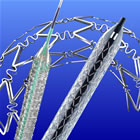 Is this stent necessary? Is this angioplasty inappropriate? Is this cardiologist uncertain if the procedure will help? Ever since the Appropriate Use Criteria for Coronary Revascularization were published, the three category labels of “appropriate,” “uncertain,” and “inappropriate” have confused the profession, press and population at large. The issue of definitions had still not been addressed in the most recent update of the AUC.
Is this stent necessary? Is this angioplasty inappropriate? Is this cardiologist uncertain if the procedure will help? Ever since the Appropriate Use Criteria for Coronary Revascularization were published, the three category labels of “appropriate,” “uncertain,” and “inappropriate” have confused the profession, press and population at large. The issue of definitions had still not been addressed in the most recent update of the AUC.
So (drumroll, please) yesterday, new categories were approved by the ACC Appropriateness Use Criteria Working Group. The new terminology will be “Appropriate,” “May Be Appropriate”(which replaces “Uncertain”), and “Rarely Appropriate” (which replaces “Inappropriate”).
I have written about this a number of times, most recently last December in my post, “A Stent By Any Other Name,” in which I called for a change:
“My recommendation is that a committee be organized to rework the terminology used in the guidelines — a kind of guidelines for the guidelines committee. And this committee should be tasked with the goal of creating better labels and ways to communicate the safety and efficacy of these procedures to the public, as well as to the profession, payers and politicians. And, I would highly recommend that such a committee consist not just of doctors and scientists, but of members who are, in effect, wordsmiths: writers, journalists…perhaps even bards….”
Well, that has now happened. Although bards were not utilized — instead surveys of members of the medical community were used — in some cases SurveyMonkey polls were used (and, if you think I’m going to now make a joke about “bards” and “monkeys at typewriters” — well, I just did).
So, is this earth-shaking news? Well, kind of….
Dr. Paul Chan, who published a major study in JAMA last year on “Appropriateness of Percutaneous Coronary Intervention” wrote me this morning that:
“I am glad they are changing the semantics to lessen confusion in the lay press and media. This is a welcomed change that will help us as a community of cardiologists move beyond semantics to the real issue of ensuring that patients who undergo PCI receive benefit from their procedure.“
What these new terms accomplish is to refocus these semantic definitions back to the clinical judgement of the physician. For example, as I have written, “uncertain” or “inappropriate” really meant that there had not been sufficient evidence in clinical trials to support wholesale use of PCI in this situation, very possibly because the specific presentation of a patient may have been excluded from the trial. Therefore it’s left to the doctor’s best judgement (hopefully in partnership with the patient’s decision-making process) as to whether an intervention might be beneficial.
There’s a definite difference in saying this procedure is “uncertain”, as opposed to “may be appropriate.” Especially for the news media. For example, CNN’s report on Dr. Chan’s study stated, “Half of all procedures done to widen arteries in non-emergency situations may be unnecessary.” In their report, the categories of “uncertain” and “inappropriate” were conflated and relabeled “unnecessary.” These new terms should help avoid these mass media misinterpretations.
Again the new terms are as follows:
- “Appropriate” – no change
- “May Be Appropriate” – replaces “Uncertain”
- “Rarely Appropriate” – replaces “Inappropriate”
Got it?
(updated November 6, 2012 – 4:10 PM with extended quote from Dr. Chan)



